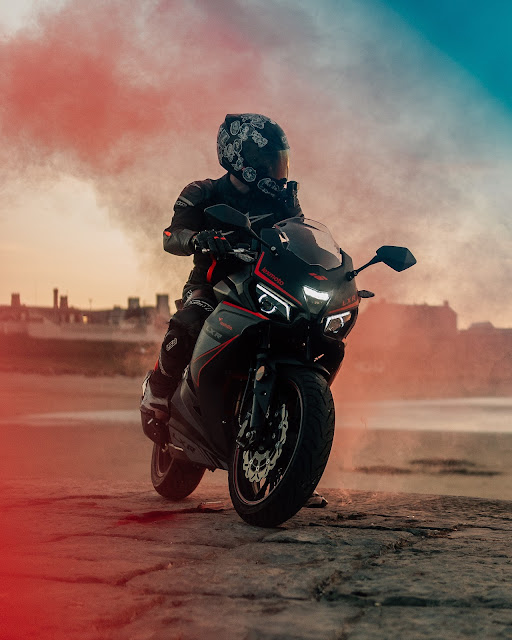When it comes to riding a motorcycle, safety should always be a top priority. Motorcycles offer a sense of freedom and excitement that few other vehicles can match, but they also come with an increased level of risk. That's why having the right safety gear is essential for every rider.
In this blog post, we'll focus on the key safety gear for motorcyclists and explain why each piece is so crucial.
1. Helmet
Your head is the most vulnerable part of your body when you're riding a motorcycle, and that's why a helmet is the single most important piece of safety gear you can own. A high-quality, DOT-approved helmet can mean the difference between life and death in the event of an accident.
It not only protects you from head injuries but also shields your eyes and face from wind, debris, and insects. When choosing a helmet, make sure it fits snugly and comfortably, and replace it if it's been involved in a crash, as helmets are designed for one-time use in such situations.
2. Riding Jacket
A riding jacket isn't just about style; it's a crucial part of your safety gear. These jackets are designed to provide abrasion resistance in case of a fall, and many also come with armor or padding to protect your shoulders, elbows, and spine. Whether you opt for a leather or textile jacket, make sure it fits well and offers the level of protection you need.
3. Gloves
Your hands are often the first point of contact with the ground in the event of an accident. That's why it's vital to wear proper motorcycle gloves. Full-fingered gloves made specifically for motorcycle riding protect your hands from abrasion and impact. They also provide better grip and control, especially in wet conditions.
4. Pants
Motorcycle pants or riding trousers protect your legs in the event of a crash. They are typically made from reinforced materials such as leather, textiles, or Kevlar. These materials can prevent road rash and minimize injury to your lower body. Ensure that your riding pants are comfortable and offer a good fit for ease of movement while riding.
5. Boots
Your feet and ankles are vulnerable areas that need protection. Motorcycle-specific boots provide the necessary support and protection for your feet and ankles. They are designed to prevent twisting or breaking in case of an accident and offer superior grip on footpegs and the road.
6. Eye Protection
Eye protection is often overlooked but is a critical aspect of motorcycle safety gear. Debris, wind, and insects can impair your vision while riding. Goggles, sunglasses, or a visor attached to your helmet can shield your eyes, ensuring a clear view of the road ahead. If your helmet doesn't have a built-in visor, it's essential to invest in high-quality eye protection.
7. Back Protector
In the unfortunate event of a crash, protecting your spine is of utmost importance. A dedicated back protector, either in the form of a standalone insert or integrated into your riding jacket, can provide crucial impact resistance for your spine and back. This added layer of protection can make a significant difference in minimizing injury.
8. Ear Protection
The noise of the wind and the motorcycle engine can be deafening, especially during high-speed rides. Prolonged exposure to such noise levels can lead to hearing damage and fatigue. To mitigate this risk, invest in ear protection, such as earplugs or noise-canceling earphones. Not only will these protect your hearing, but they will also make for a more comfortable and enjoyable ride.
9. High-Visibility Gear
Visibility is a critical factor in motorcycle safety. In many accidents involving motorcycles, the other vehicle involved claims not to have seen the motorcyclist. To enhance your visibility on the road, consider wearing high-visibility clothingor adding reflective accessories to your gear. These can make a significant difference, especially in low-light conditions or at night.
10. Rain Gear
Weather can change unexpectedly, and riding in the rain without the right gear can be both uncomfortable and dangerous. Waterproof gear, such as a rain suit or waterproof layers, will keep you dry, maintain your comfort, and ensure you remain focused on the road ahead. Wet riding conditions can significantly increase the risk of accidents, so being prepared for rain is a key aspect of safety.
Conclusion
Staying safe on a motorcycle should always be a rider's top priority. One of the essential ways to protect yourself is by investing in quality safety gear. Each piece of gear plays a vital role in reducing the risks associated with riding. From helmets to jackets, boots, gloves, and pants, every item is designed to minimize injury in case of an accident. Whether you're a seasoned rider or just starting, never underestimate the importance of safety gear. It can save your life and make your rides more enjoyable.
But accidents still happen, and if you find yourself in need of legal assistance, it's crucial to contact a motorcycle accident attorney in Utah who can help you navigate a complex legal system and obtain the compensation you deserve. With the right gear and legal support, you can ride safely and confidently and enjoy the freedom of the open road.


